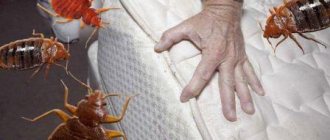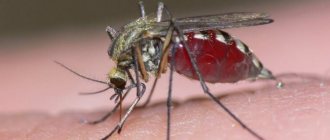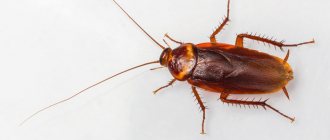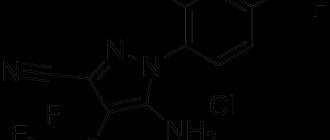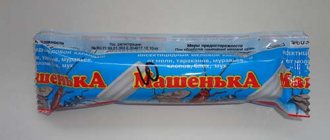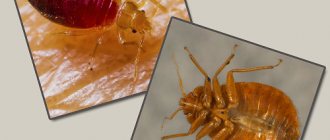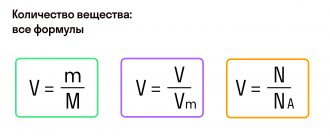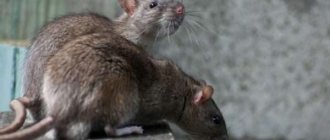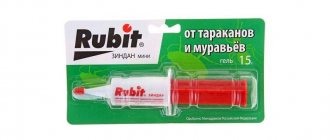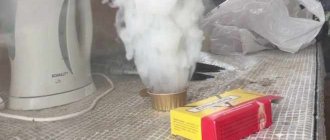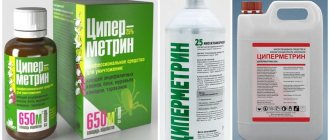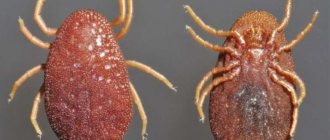The term “dust” is well known to all residents of the post-Soviet space who were lucky enough to be born during the Soviet era. Then this remedy was known both as a powder for cockroaches, and as a cure for lice, and as a means of fighting garden pests. DDT is one of the most effective insecticides ever invented by man.
This gray-white powder with shades of blue-violet could be purchased even in ordinary hardware stores; it was widely used against insect parasites, both in humans and domestic animals. The history of this powder, which at one time saved humanity from malaria, is well known.
However, over time, the situation regarding this remedy has changed significantly. Today it is almost impossible for an ordinary consumer to purchase dust in its pure form. DDT is produced in limited quantities and is available only to a narrow circle of specialists from sanitary and epidemiological services.
Such restrictions are associated with the high toxicity of the product if the dosage is not followed, as well as the relatively recently discovered ability of DDT to accumulate in soil, plants and living tissues.
Dust is officially banned for any use in many countries, but the World Health Organization has left the possibility of its use in case of malaria.
Today, a number of insecticidal products are produced under the term “dust”, which use this definition as an advertising ploy. There is no trace of DDT in these products, but marketers use the term “dust” due to the fact that this is the name given to the fine powder. “Dust” translated from English means “fine powder”. Actually, even flour could be called dust.
Listed below are the main commercial products, the name of which includes the definition of “dust” and which are used against various insect pests and parasites.
Physicochemical characteristics
DDT or dichlorodiphenyltrichloromethylmethane is a substance in the form of white crystals, poorly soluble in ordinary water, better diluted in organic and other solvents. Dichlorodiphenyl trichloromethylmethane has a sharp, characteristic odor. DDT is also called another insecticide - dichlorodiphenyltrichloroethane, which has a similar effect.
Various inert materials are used as fillers in the preparation: kaolin, chalk, talc, clays, silica gel and others. The amount of active substance is regulated by the activity of the drug and its purpose; it is 1-10%.
The dust has a long shelf life compared to many other pesticides; it can be stored in a cold room and at elevated temperatures.
Advantages and disadvantages
The positive features of dust include:
- availability and reasonable price;
- There is a large selection of powdered insecticides in stores;
- no pungent odor;
- If you follow all the rules when using, the dust will not have a negative effect on people and animals;
- easy and simple use;
- is effective against cockroaches and other parasites;
- has a long residual effect - after treating the apartment, the insecticidal effect lasts for a month or longer;
- the properties of the insecticide do not change under the influence of ultraviolet rays, low and elevated temperatures.
But there are negative qualities:
- after treatment, toxic powder may remain on the floor for a long time;
- the product may complicate cleaning;
- positive results do not appear immediately, but after some time.
Dust against cockroaches is considered an effective insecticide that can remove parasites from the apartment. It is necessary to know the composition, effect of the drug, as well as the features of its use.
Do not forget that this remedy can have a negative impact on human health, but only if it is used incorrectly.
Impact on pests
The pesticide specifically affects the transmission of nerve impulses in pests; it disrupts the interaction between sodium and potassium in the membranes of nerve cells. After long-term use of a chemical substance, insects can develop an addiction, as well as to other COCs. Various types of insects can become resistant, such as potato beetles, house flies and mites.
Expert opinion
Zarechny Maxim Valerievich
Agronomist with 12 years of experience. Our best country expert.
Ask a Question
In tank mixtures, dust is used together with hexachlorane; when used together, the effect of the substances is enhanced.
Description of the substance
Dust is a preparative form of the drug. However, the active ingredients are different. The product is produced in powder form. A standard example of an insecticide is DDT, or dichlorodiphenyl trichloromethyldi(p-chlorophenyl)methane. It is produced by condensing chlorobenzene and chloral in highly concentrated sulfuric acid.
In form, DDT is a white crystalline substance that is tasteless and practically odorless. The preparative form of the chemical is considered to be powder. However, in epidemiological situations it is worth using an aqueous solution.
In everyday life, poison is often called dust. This term was originally used to refer to the powdered form of DDT. It is an external insecticide that leads to the death of pests upon external contact with the substance. This is achieved by damaging the nervous system of the parasite.
Instructions for use
Dust was used against insects - pests of crops and carriers of various infections in animals. This drug was produced in different concentrations: 5.5% and 10% of the powder used for dusting.
See also
Instructions for use and composition of the Vial Trio disinfectant, consumption ratesRead
Wettable powders of 30 and 50% concentration and concentrated mineral oil emulsion of 20% were intended for the production of aqueous suspensions. Technical dust was used on large areas of collective farms.
Dust was previously used as an important contact insecticide to control leaf-eating insects on almost all crops. You can spray the solution or sprinkle it with dry powder if for some reason it is difficult to prepare the solution. Sprinkle with a thin layer, work in the absence of wind so that the powder does not blow to the side onto other plants.
Precautionary measures:
The substance is toxic, so when applying it you must pay special attention to your own safety. When carrying out processing, be sure to use: gown, gloves, respirator, goggles
After treatment, wash your face and hands thoroughly. Wash the robe with powder or take it to the dry cleaner.
After three hours, wash out the chemicals and ventilate the apartment. It may take several days for the unpleasant odor to completely disappear.
Before you start using the dust, be sure to determine whether there are bedbugs in your home. This can be determined by the following signs:
1) Pay attention to the body if you have bites and whether they exactly look like bed bug tracks 2) Traces of insect excrement resemble red crumbs 3) Bloodsuckers emit a very unpleasant odor that cannot be confused with anything 4) Only open areas are affected by insect bites bodies.
Safety precautions for use
Dust does not linger well on vertical surfaces. The powder collects dust easily, so it is not recommended to work in windy conditions. When stored in a humid room, the dust cakes.
It has been established that dust can accumulate in adipose tissue. It is poorly soluble in water, but accumulates in aquatic organisms to high concentrations. It can accumulate in plants, animals, and then in the human body. In the next link of this peculiar chain, the concentration can increase by an order of magnitude.
Due to the low solubility of dust in water and significant solubility in fats, it is retained in fat cells. The rate of accumulation of the compound depends on the concentration, duration of exposure, animal species and conditions. Toxic effects may occur over a long period of time after the compound accumulates in the body.
Dust can be present in the soil for up to 12 years; in conditions without the presence of air, bacteria decompose it within 2-4 weeks. At elevated temperatures, decomposition occurs faster.
How dust affects people: it is dangerous for humans; poisoning can occur even in small doses, but without noticeable consequences. In large doses it leads to death. The compound may be present in the blood, penetrate into adipose tissue, and milk.
Dust affects the immune system, inhibits the activity of enzyme substances, and inhibits the creation of antibodies. Does not have a mutagenic, carcinogenic or fertility-reducing effect, and does not have a toxic effect on embryos.
When working with dust in any preparative form, you must strictly follow your own safety rules. It is necessary to work in clothes that will cover the entire body, that is, wear trousers, a long-sleeved shirt, a respirator and glasses on the face. Hands must be protected with long rubber gloves.
After finishing the treatment, you need to wash your hands and face with soap, remove and wash your clothes. Dry it. If the solution gets on your skin, wash it off with water to avoid irritation. Rinse your eyes if the substance gets into them. Rinse if liquid or powder enters the stomach. Rinse with activated carbon and water (1 liter and 6-7 tablets). After 15 minutes of administration, induce vomiting. If it does not improve, be sure to seek medical help.
Expert opinion
Zarechny Maxim Valerievich
Agronomist with 12 years of experience. Our best country expert.
Ask a Question
Symptoms of poisoning: feeling tired, pain in the head, arms and legs, palpitations, loss of appetite, nausea, vomiting. Pain may be felt in the area of the pancreas, right hypochondrium, the kidneys may be affected, and the liver may become enlarged. Symptoms may include loss of sensation, paralysis, and hyporeflexia. If the poisoning is severe, the temperature may rise, shortness of breath, blurred vision, increased heart rate, and convulsions may occur. In acute poisoning, death may occur within 1-2 hours.
Acute intoxication is possible when inhaling the powder, symptoms appear after 4-5 hours, these are weakness, nausea, drooling, runny nose, conjunctivitis, dizziness, fever, then bronchitis or tracheitis may develop as a sign of damage to the respiratory system. If the dust gets on the skin, poisoning is also possible, which begins with skin irritation. If the substance gets into the eyes, pain may occur in them and conjunctivitis may develop.
See also
Instructions for use and composition of Liposam adhesive, consumption ratesRead
Symptoms of chronic intoxication after prolonged contact with dust: headache, sudden fatigue, loss of appetite, cramps and pain in the limbs, sweating, trembling in the legs and arms, palpitations, shortness of breath, polyneuritis, emotional instability, tingling in the arms and legs. There may be numbness in the forearms, changes in vision and speech, hepatitis, bronchitis, gastritis, impaired kidney function, eczema and other skin diseases may develop.
Dust production
Pesticides can be powdered more or less easily depending on their properties.
The most easily crushed substances are those with a well-formed crystalline structure, which have a fairly high fragility and low ductility. As a rule, technical products containing oily impurities are more difficult to grind. When grinding in ball mills, such products clump and form large aggregates that stick to the walls of the mill. The inert filler prevents the preparation from clumping, both during the grinding process and during storage of the prepared powder. The amount of filler added depends on its sorption capacity; The higher the sorption capacity of the filler, the less of it is required to obtain a good grinding product.
When grinding in ball mills and other similar units, as a result of impacts of the balls, a slight increase in temperature occurs, as a result of which partial melting of the pesticide is possible. Therefore, when grinding in ball mills, a slightly larger amount of filler should be added, and grinding should be carried out at the lowest possible temperature. Ball mills with air separation are most often used. Sometimes grinding is carried out in two stages: first, a concentrated powder is prepared (grinding on runners, in a ball mill or other type of units), which is then diluted with filler and additionally ground in a ball mill. Good quality dusts are obtained when using an air-jet mill, but the cost of the product in this case increases significantly due to the high energy consumption.
Of interest is the method of producing dusts by mixing molten pesticide with ground filler. Several modifications of this method are known for the preparation of low-melting pesticide dusts with high plasticity. Dusts from liquid organophosphorus pesticides are easily obtained in this way. However, when preparing organophosphorus pesticide dusts, it is necessary to strictly approach the choice of filler. It should be kept in mind that some excipients promote the isomerization of thiophosphates and dithiophosphates into more toxic compounds. This, in particular, was discovered for karbofos. To prepare organophosphorus pesticide dusts, you should not use alkaline fillers that hydrolyze the pesticide.
The basic technological flow diagram for the production of dusts is shown in the figure.
If the pesticide is a liquid, it is injected into the mixer using special nozzles. In this case, it is recommended to use crushed filler, which makes it possible to eliminate the grinding stage in the production of dust and limit ourselves to two-stage mixing.
Analogs
For household use against household pests, you can use “Klopoveron”, “Riapan” with the active substance permethrin, “Phenaxin” with the active substance fenvalerate, “Fas-double” against bedbugs, “Hexachloran” and others.
In agriculture, dust can be replaced with insecticides with various active ingredients. These are more modern drugs that are not inferior to it in effectiveness, but are much safer.
Dust is the first effective synthetic insecticide, which has been used since the 40s of the 20th century. Despite its effectiveness, its use is not recommended because it is toxic and often causes poisoning, especially if used frequently. Now there are drugs that can replace this substance and will not harm plants, soil, or animals.
Composition and mechanism of action
There are dusts from different manufacturers, but their composition and operating principle are the same. The only difference can be in packaging and volume. The drug is a highly effective insecticide for controlling parasitic insects.
The product contains the following active substances:
- Cypermethrin;
- Tetramethrin;
- Melathion;
- Solvent;
- Lubricant;
- Piperonyl butoxide;
- Boric acid;
- Pyrethrum.
The content of the components ensures the effectiveness of the dust. And if you use it correctly and follow all recommendations and instructions, the drug will not have a negative effect on people and pets.
How dust acts on cockroaches is indicated in the instructions, which describe the detailed mechanism of the drug’s effect on parasitic insects.
The product belongs to the contact-intestinal group of insecticides, which means that the parasite, having come into contact with the powder and having tasted it, receives a lethal dose of the toxic substance.
First of all, a cockroach experiences a disruption in the activity of its nerve cells, and after that its internal organs stop functioning fully. This leads to death.
At the same time, the dust has a prolonged effect, that is, it prevents further appearance of insects.
Review of modern manufacturers of insecticidal powders
The most common dust-based products:
“Clean House” is an anti-bedbug dust that shows first results in just two days. Universal, but more often used against cockroaches and ants. A common question about “clean house” dust is whether this product kills or euthanizes bedbugs. So, the presence of cyper- and tetramethrin (very effective insecticides) in the composition allows “Clean House” to have a complex nerve-paralytic effect;
"Clean house"
"Klopoveron" is used mainly by industrial enterprises that specialize in exterminating insects (due to its high cost). It is unique because it instantly paralyzes bedbugs due to the presence of a synthetic insecticide in the composition;
Klopovetron
"Phenaxin" is an inexpensive product (about 20 rubles per 125 g). It is odorless, therefore it is widely used in kindergartens, schools, canteens, and hotels. This dust is based on boric acid and fenvalerate, which guarantee its effectiveness;
Phenaxin
“Pyrethrum” is developed on the basis of natural ingredients and is therefore absolutely non-toxic. It is preferable to use in the initial stages of bedbug spread. The peculiarity of this type of dust is the need for regular reapplication (every 2-3 days);
Pyruthrum
"Riapan" is intended for processing furniture and fabrics. Requires continuous application over the entire surface. The main component is permitrin, which will completely destroy the population in about 3 weeks;
Riapan
“Fas-double” is a powder that must be diluted with water before use. This solution is the most effective of the available (affordable) products. Acts not only on bedbugs, but also on fleas, flies, cockroaches and ants;
Front-double
"Biocyfen" is used in everyday life, in medical and food establishments. The nature of the impact is intestinal and contact. Active for five weeks.
Biocyfen
It is impossible to choose the best one among the listed means, but the most suitable one is easy based on the following factors:
- Speed: “Klopoveron”, “Face-double”;
- Versatility: “Clean House”, “Biociphen”;
- Cost: “Phenaxin”, “Fas-double”;
- Safety: “Pyrethrum”, “Biocyfen”;
- Duration of action: "Riapan", "Biociphen".
Advantages and disadvantages of such processing
In comparison with other methods of treating a room, dust has the following advantages:
- Availability;
- Easy to use;
- Versatility;
- Low level of toxicity;
- Economical (sold in small bags).
The disadvantages include
- Unoptimized consistency, lack of special means for application;
- Low content of poisons and, as a result, the absence of instant results.
conclusions
The obvious “lack of disadvantages” in comparison with the number of advantages of this powder, safety for humans and a wide choice when purchasing the product were appreciated by insect fighters who actively use dust when treating premises against pests.
